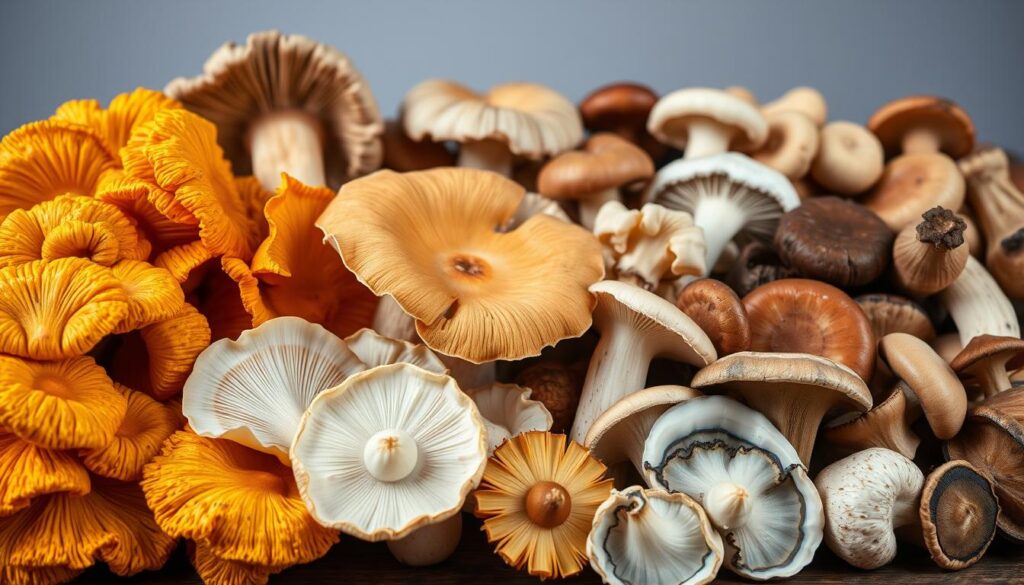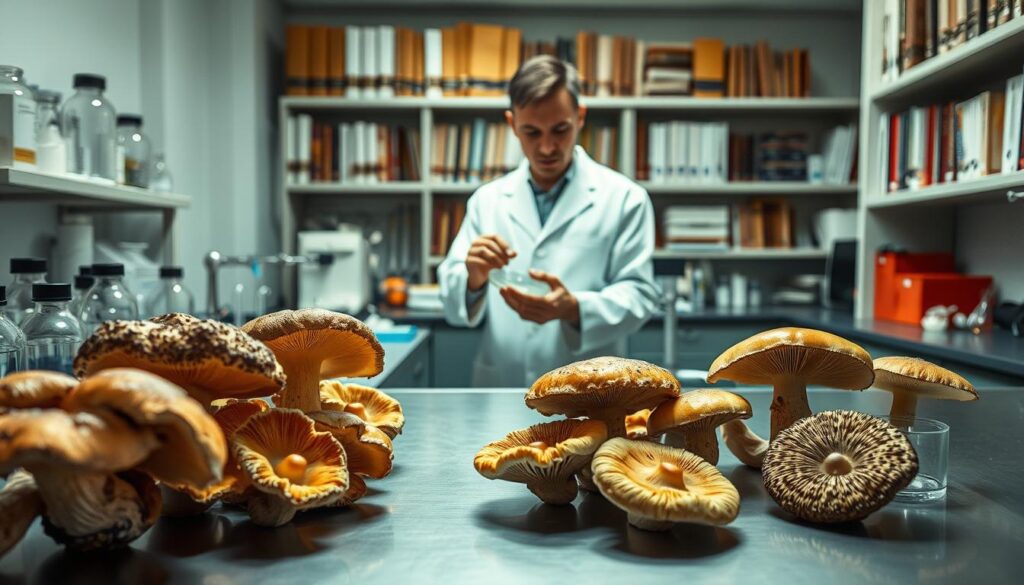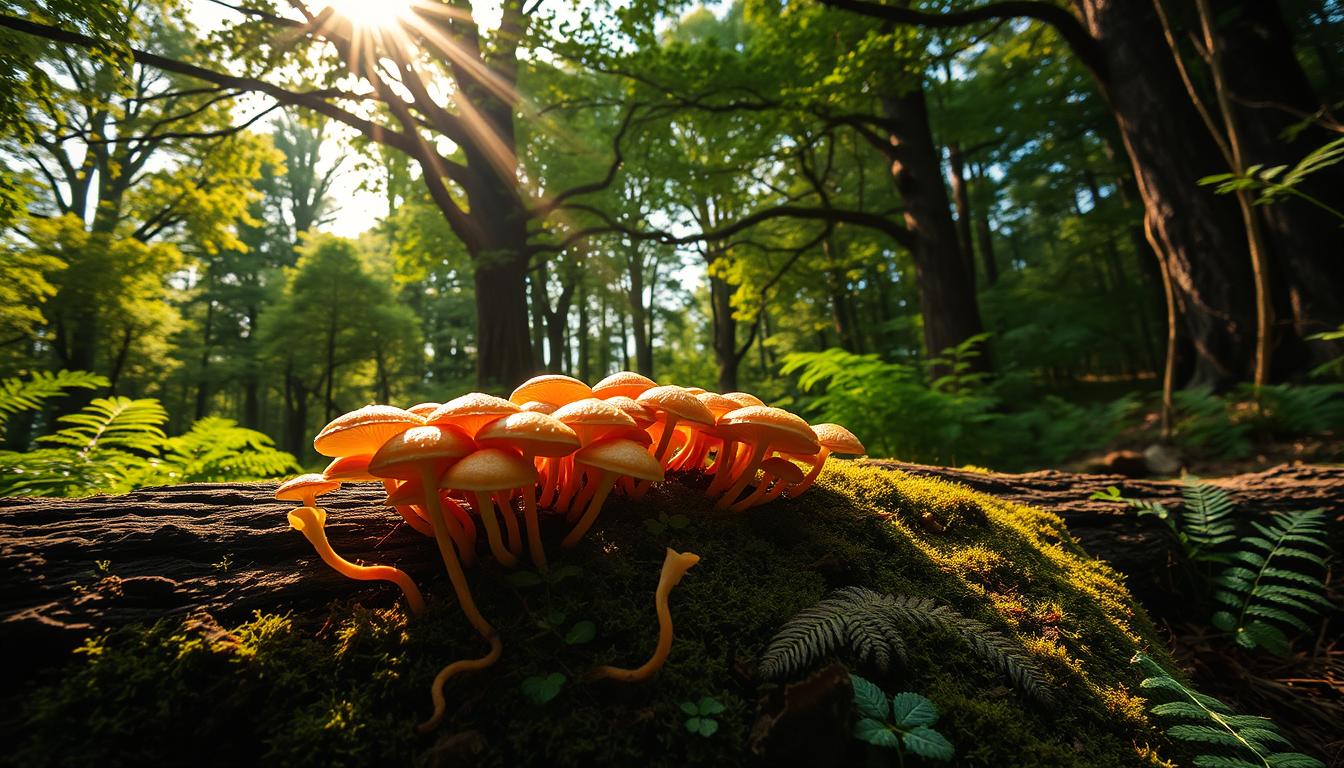Imagine walking through a misty forest with sunlight peeking through the trees. Suddenly, you spot a cluster of vibrant tree mushrooms. These forest dwellers hold secrets that could change how we see nutrition and wellness.
Tree mushrooms are nature’s hidden powerhouses. They thrive in forest ecosystems and offer amazing health benefits. As edible mushrooms, they blend culinary delight with medicinal potential.
In this journey, you’ll learn how these fungi boost your immune system and provide essential nutrients. They also connect us to the complex world of forest ecology. Get ready to be amazed by the incredible potential of tree mushrooms.
Table of Contents
Understanding Medicinal Tree Fungi
Tree mushrooms are a world of wonder, linking forests to human health. They play a big role in mycology. They show us how nature heals and works together.
To identify fungi, you need to know how they connect with trees. Mycorrhizal associations show how mushrooms and trees work together. This teamwork supports the whole forest.
What Makes Tree Mushrooms Special
Tree mushrooms are different from those that grow on the ground. Here’s why:
- They grow right on tree bark or wood
- They have special ways to survive
- They have strong medicines
- They have secret networks underground
Common Types of Tree-Growing Fungi
| Fungi Type | Primary Location | Medicinal Potential |
|---|---|---|
| Reishi | Hardwood Trees | Immune Support |
| Shiitake | Deciduous Forests | Cardiovascular Health |
| Lion’s Mane | Broad-Leaf Trees | Neurological Function |
Basic Mushroom Anatomy
Knowing how mushrooms are built is key to identifying them. Each mushroom has important parts:
- Mycelium: An underground network-like root
- Fruiting Body: The part you see above ground
- Spores: How mushrooms spread
These amazing organisms keep surprising scientists. They show us their complex ways and health benefits.
The History and Traditional Uses of Tree Mushrooms
For thousands of years, wild mushroom hunting has been woven into human history. It spans across many cultures. People have always found tree mushrooms valuable through their foraging skills and passed-down knowledge.
In Traditional Chinese Medicine, tree mushrooms were key for healing. They were prized for their ability to support the spleen and boost qi (vital energy). The complex polysaccharides in these mushrooms are crucial for holistic health.
- Asian cultures developed sophisticated foraging techniques
- Native American tribes used tree mushrooms for medicinal purposes
- European herbalists incorporated fungi into traditional remedies
Indigenous communities around the world knew a lot about wild mushroom hunting. They knew which tree mushrooms were good for nutrition and health. Foraging was more than just a survival skill; it was a cultural practice that connected people with nature.
“Mushrooms are the interface between life and death in the forest” – Paul Stamets, Mycology Expert
Different places had their ways of using tree mushrooms. In Siberia, some mushrooms were seen as sacred. In the Pacific Northwest, indigenous groups used certain fungi for food and healing.
The history of tree mushrooms shows our long connection with these organisms. From ancient medicine to today’s science, they continue to fascinate and offer insights into natural healing and nutrition.
Health Benefits of Tree Mushrooms
Tree mushrooms are full of nutrients and offer amazing health benefits. They are not just tasty but also support your overall health. Studies show they can help prevent chronic diseases.
Exploring mushroom recipes reveals many health benefits. These fungi boost your body’s natural defenses.
Immune System Support
Tree mushrooms have beta-glucans that boost your immune system. These compounds help your body fight off infections better.
- Enhance white blood cell production
- Stimulates immune system response
- Protect against potential infections
Antioxidant Properties
Your body fights off free radicals every day. Tree mushrooms are great at fighting these harmful molecules.
| Antioxidant | Benefit | Concentration in Mushrooms |
|---|---|---|
| Ergothioneine | Cellular protection | Highest among food sources |
| Glutathione | Detoxification | Significant levels present |
Anti-inflammatory Effects
Chronic inflammation can cause many health problems. Tree mushrooms have natural anti-inflammatory properties that can help.
A Penn State study found eating five mushrooms a day can protect against heart disease, cancer, and dementia.
Adding these amazing mushrooms to your diet is a smart choice for your health. It’s a step towards a healthier future.
Nutritional Profile of Forest Fungi
Edible mushrooms from the forest are nutritional powerhouses. They offer a lot of health benefits. These fungi are low in calories but high in nutrients, making them great for your diet.
The nutritional profile of tree mushrooms is amazing. They are full of vitamins and minerals that help your body stay healthy. They provide a mix of nutrients, including:
- B-complex vitamins for energy metabolism
- Vitamin D for bone health
- Potassium for heart and muscle function
- High-quality dietary fiber for digestive support
What’s special about these forest fungi is their ability to offer a lot of nutrition with few calories. Mushrooms are essentially nature’s multivitamin. They grow in complex forest ecosystems, making them very nutritious.
Compared to other foods, mushrooms are unique. They have antioxidants and minerals that boost brain function, strengthen the immune system, and help cells stay healthy.
| Nutrient | Amount per 100g | Health Benefit |
|---|---|---|
| Protein | 3-5g | Muscle maintenance |
| Fiber | 2-3g | Digestive health |
| Vitamin D | 100-200 IU | Bone strength |
Adding these nutritional gems to your diet can unlock the healing power of forest mushrooms. You’ll also enjoy their rich, earthy flavors.
Identifying Safe Tree Mushrooms
Wild mushroom hunting needs careful attention and expert knowledge. Your safety depends on knowing how to identify fungi correctly. It’s also important to know the difference between safe and toxic mushrooms on trees.
Foraging for tree mushrooms requires precision and caution. To learn to recognize safe fungi, you must study many characteristics. These help you tell edible species from dangerous look-alikes.
Key Recognition Features
- Examine the mushroom’s cap shape and texture
- Inspect the undersides for specific gill or pore patterns
- Check the stem’s color, thickness, and attachment
- Observe growth locations on different tree types
- Note seasonal variations in mushroom appearance
Common Poisonous Look-alikes
| Edible Species | Toxic Counterpart | Key Differences |
|---|---|---|
| Oyster Mushroom | Jack-o-Lantern Mushroom | Bioluminescent gills, darker coloration |
| Chicken of the Woods | Sulfur Shelf | Brighter orange, smoother texture |
| Lion’s Mane | Poisonous Coral Fungus | Different growth pattern, branching structure |
Best Foraging Practices
- Always carry a reliable field guide
- Use high-quality identification tools
- Take clear photographs for expert verification
- Never consume without 100% identification
- Learn from experienced local mycologists
Remember: When in doubt, throw it out. No mushroom is worth risking your health.
Most Popular Edible Tree Mushrooms

Exploring edible mushrooms is a culinary adventure. Tree mushrooms add unique flavors and health benefits to your cooking. They can make your dishes special, whether you’re a pro chef or a home cook.
Some top edible tree mushrooms are:
- Oyster Mushrooms: These are delicate and mild. They grow on dead trees. Great for stir-fries and pasta.
- Shiitake Mushrooms are from East Asia, they have a rich flavor. Perfect for Asian dishes.
- Maitake Mushrooms: Known as “hen of the woods”, they taste earthy. Ideal for risottos and sauces.
To prepare the tree mushrooms, clean them gently with a soft brush. Don’t soak them in water. Each mushroom type adds its taste and texture to your meals. Try them out to find new flavors.
Experts say to pair these mushrooms with garlic, thyme, and white wine. This boosts their natural taste. Your mushroom dishes will be amazing once you learn how to use these forest gems.
Sustainable Harvesting Practices
Wild mushroom hunting is all about finding a balance. It’s about enjoying the hunt while keeping the forest healthy. This balance is key to preserving mushroom ecosystems for the future.
Foraging is more than just picking mushrooms. It’s about respecting the forest’s complex life and keeping it intact. This means we must avoid harming the environment.
Environmental Impact of Mushroom Harvesting
Mushrooms are vital to the forest. Our actions can greatly affect the ecosystem. By harvesting carefully, we help keep the forest’s balance.
- Protect mycelium networks underground
- Use gentle collection techniques
- Avoid damaging surrounding vegetation
- Leave some mushrooms for natural reproduction
Conservation Guidelines
When we hunt for mushrooms, we must be mindful. Here are some key steps to protect the environment:
- Use sharp knives for clean cuts
- Remove only mature specimens
- Carry collection baskets that allow spore dispersal
- Learn local regulations about foraging
Best Harvesting Seasons
Timing is everything in mushroom hunting. Each type of mushroom has its best time to pick. This helps keep the ecosystem healthy.
| Mushroom Type | Optimal Harvesting Season | Ecological Considerations |
|---|---|---|
| Oyster Mushrooms | Late Summer/Early Fall | Minimal ecosystem disruption |
| Chicken of the Woods | Late Summer | Supports forest decomposition |
| Lion’s Mane | Early Fall | Preserves reproductive cycles |
By following these guidelines, we can enjoy mushroom hunting responsibly. This way, we protect the forest and its wonders for everyone to enjoy.
Preparing and Storing Tree Fungi
Learning how to prepare and store edible mushrooms can change your cooking. It keeps their taste and health benefits. Fresh tree mushrooms need careful handling to keep their unique flavors.
Cleaning your mushrooms is the first step in making mushroom recipes. Gently brush off dirt with a soft brush or a damp paper towel. Don’t soak mushrooms in water, as they get soggy fast.
- Clean mushrooms just before cooking
- Remove any tough stems
- Slice food uniformly for even cooking
There are ways to keep your tree fungi fresh for longer. Drying is a great method for long storage. It makes mushrooms flavorful and easy to store.
| Preservation Method | Storage Duration | Best Mushroom Types |
|---|---|---|
| Refrigeration | 3-5 days | Shiitake, Cremini |
| Freezing | 6-12 months | Oyster, Reishi |
| Drying | 1-2 years | Porcini, Chaga |
When cooking mushrooms, think about their textures and tastes. Shiitake mushrooms are great in stir-fries. Cremini mushrooms add flavor to pasta dishes and risottos.
Pro tip: Always cook mushrooms thoroughly to enhance digestibility and unlock their rich nutritional profile.
Medicinal Applications in Modern Medicine
Modern mycology has opened up new possibilities for tree mushrooms in medical research. These fungi are changing how we see natural healing and drug development. Scientists are finding amazing uses for edible mushrooms, linking old wisdom with new medicine.

The world of mycology is showing us the incredible healing power of tree mushrooms. Researchers have found many areas where these fungi could change medical treatments.
Research-Backed Benefits
Recent studies have shown many benefits of tree mushrooms:
- Potential immune system boost
- Help with cholesterol levels
- Manage blood sugar
- Anti-inflammatory effects
Clinical Studies Overview
Recent studies have made big strides in understanding edible mushrooms’ healing power. Researchers are excited about compounds like beta-glucans. They think these could:
- Help with heart health
- Lower diabetes risk
- Improves metabolic functions
Though more research is needed, early results are promising. Tree mushrooms might soon be key in preventing and treating diseases. Your health care could include these natural compounds in new ways.
Cultivation Techniques for Tree Mushrooms
Mushroom cultivation needs careful attention and knowledge of mycorrhizal associations. Growing tree mushrooms starts with picking the right environment and substrate. Each species has its own needs, so research is key for success.
Successful mushroom cultivation involves several key strategies:
- Understand the specific needs of your chosen mushroom species
- Select appropriate growing substrates
- Maintain optimal temperature and humidity
- Ensure proper air circulation
- Monitor for potential contamination
Outdoor log cultivation is a favorite for growing tree mushrooms. Choose hardwood logs like oak or maple for a great substrate. Inoculation involves drilling holes and adding mushroom spawn, letting mycorrhizal associations grow naturally.
“The art of mushroom cultivation is both science and patience.” – Mycology Expert
Indoor controlled environments offer precise growing conditions. You can manage temperature, humidity, and light. Specialized grow bags or shelving units can turn a small space into a productive mushroom area.
Small-scale mushroom farming is an exciting, sustainable practice. With little investment, you can grow nutritious fungi and help local food systems. Your efforts can bring fresh, organic mushrooms right to your space.
Safety Considerations and Precautions
When you explore tree mushrooms, your safety is key. Wild mushroom hunting needs careful steps to avoid risks. Knowing how to identify fungi is vital.
It’s important to know the dangers of mushroom foraging. Some people might have allergies to certain mushrooms. So, knowing what you’re picking is crucial.
- Always consult an expert mycologist before consuming wild mushrooms
- Learn to recognize dangerous look-alike species
- Wear protective gear during mushroom hunting
- Carry a reliable field guide for fungi identification
Here are some key safety tips for mushroom hunting:
- Never eat a mushroom you can’t identify for sure
- Use many ways to check what you find
- Start with small amounts of new mushrooms
- Watch for any allergic reactions
| Safety Aspect | Recommended Action |
|---|---|
| Identification | Use professional guides and expert verification |
| Harvesting | Wear gloves and use clean cutting tools |
| Consumption | Cook thoroughly and consume small amounts initially |
Before adding medicinal mushrooms to your routine, talk to healthcare professionals. They can give advice based on your health and any medicines you take.
Remember, learning about fungi and mushroom hunting is ongoing. It takes patience and respect for nature’s complexity.
Conclusion
Tree mushrooms are a world of wonder, linking forest life to human health. They show how fungi can help us and the environment. This journey shows their power to heal and support our planet.
Tree mushrooms play a big role in forests. They do more than just grow on trees. They help trees talk to each other and support the forest’s health. They also boost our immune system and offer great nutrition.
Learning about tree mushrooms changes how we see food, medicine, and nature. They open doors to new ways of eating, studying, and caring for our planet. Tree mushrooms are a key to understanding our world better.
It’s important to learn about and protect these forest wonders. By supporting safe harvesting and conservation, we help keep forests healthy. This way, we can enjoy the amazing gifts tree mushrooms give us.
FAQ
What exactly are tree mushrooms?
Tree mushrooms are fungi that grow on trees or wood. They form relationships with living trees or decomposing wood. Unlike ground mushrooms, they thrive in forest ecosystems with unique traits.
Are all tree mushrooms edible?
No, not all tree mushrooms are safe to eat. Some can be toxic. It’s important to know how to identify them safely. Always check with an expert before eating wild mushrooms.
How do I identify safe tree mushrooms?
To identify safe mushrooms, observe their color, shape, and growth. Look at the cap structure, gill, or pore patterns and how they attach to the tree. Use field guides, take photos, and consult experts for accurate identification.
What are the most common medicinal tree mushrooms?
Renowned medicinal mushrooms include Reishi, Lion’s Mane, Shiitake, and Turkey Tail. They are valued for boosting the immune system, reducing inflammation, and fighting free radicals.
Can I grow tree mushrooms at home?
Yes, it’s possible to cultivate certain types of tree mushrooms at home. Use log cultivation or indoor kits for species like oyster mushrooms and shiitake. You’ll need the right substrate, humidity, and environment.
How do tree mushrooms benefit forest ecosystems?
Tree mushrooms are vital for forest health. They help break down dead wood, recycle nutrients, and support tree health. They also create complex networks that maintain biodiversity.
What nutritional benefits do tree mushrooms offer?
Tree mushrooms are rich in protein, fiber, vitamins, and minerals. They’re low in calories yet rich in nutrients. They support immune function and provide antioxidants.
How should I store foraged or purchased tree mushrooms?
Store mushrooms in a paper bag in the fridge. This enables proper airflow and helps prevent moisture buildup. For longer storage, dry, freeze, or pickle them. Always keep them clean and dry to avoid spoilage.
Are there any risks associated with consuming tree mushrooms?
Risks include allergic reactions and poisoning from misidentification. Some may have digestive issues or allergies. Start with small amounts, ensure proper identification, and consult a doctor if you have health concerns.
What tools do I need for mushroom foraging?
You’ll need a sharp knife, basket, field guide, camera, gloves, and a brush. A GPS or smartphone app can help track locations. Always harvest responsibly to support forest regeneration.

